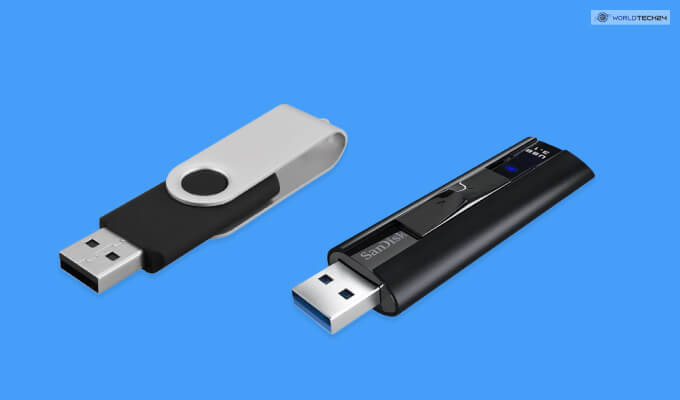If you are a tech geek interested in various types of computer technology, you already know what a USB drive is. It is a form of storage device that lets you store files of all kinds. But there are two kinds of USB drives – the thumb drive and the flash drive.
However, most people do not know what the difference between a thumb drive and a flash drive is.
Therefore, if you are one of them who does not know the difference between a thumb drive and a flash drive, then read this article now. Here, you will learn what is the difference between a thumb drive vs flash drive and what their various applications and uses are.
What Is Flash Drive?

A flash drive – as the name suggests – offers high-speed file transfer between devices and various storage options. It is a portable device, which unlike other kinds of drives, has no moving parts inside it.
They are typically made with two kinds of ports – a USB Type-A port and with USB Type-C ports. Therefore, they can be easily connected to any computer or laptop of your choice. In addition, they can be connected to your car and even your television sets as well, as long as they have USB Type A or Type C ports.
These drives make use of Compact Flash (CF), which has several magnetic properties to it that help in the storage of data.
What Is A Thumb Drive?

A thumb drive is another type of USB drive that allows you to store data and files and edit them at will. These drives are called thumb drives because of their super small size. Their sizes typically range from being around two to four inches long.
Unlike flash drives, a thumb drive can connect with USB type A ports. This is because thumb drives were created way before flash drives were. Therefore, the official support or build for supporting Type C ports has not been implemented yet.
These drives use a smaller variation of Solid State Drives (SSDs) that we all typically get to see on a computer or a laptop. Therefore, this makes it have high-speed data transfer capabilities.
Thumb Drive VS Flash Drive: What’s The Difference?

As you might have heard, many people might say that thumb drives and flash drives are more or less the same things. However, I have found several properties of both devices that make them pretty different from each other.
1. Shape And Size

When it comes to the shape and size of a thumb drive vs flash drive, then thumb drives are way smaller in size. That is one of the reasons why thumb drives are referred to as such – being around the shape of one’s thumb.
On the other hand, flash drives typically are a bit bigger compared to thumb drives. However, both of them are equally portable, though thumb drives take up less space.
2. Build Quality

Thumb drives are made with various chips inside them that store data. These chips are further coated with plastic coatings that protect them from shocks, accidental falls, and external pressure. However, these coatings degrade over time and will soon make the drive more vulnerable as time passes by.
On the other hand, flash drives are newer and make use of better architecture made with aluminum. This makes them better suited for longer periods of time compared to thumb drives. This makes flash drives the winner in the thumb drive vs flash drive durability and endurance category.
3. Type Of Memory Storage

As mentioned earlier, flash drives make use of Compact Flash (CF) drives, while thumb drives make use of SSDs. Therefore, flash drives provide faster and better data transfer speeds compared to thumb drives because CF is an upgraded version of SSDs.
In addition, thumb drives provide storage solutions for spaces in multiples like 2GB, 4GB, 8GB, 16GB, 32GB, 64GB, and 128GB. On the other hand, flash drives provide storage solutions in the same terms, albeit with faster reading and writing speeds.
Here also, the flash drive is the clear winner in the thumb drive vs flash drive comparison.
FAQ (Frequently Asked Questions):
There are various questions that tech geeks and people ask on the internet all the time. Some of these most frequently asked questions regarding thumb drives vs flash drives are:
Ans- Both flash drives and thumb drives are equally good, with both being used for different purposes. However, this is true when it comes to storing data. On the usability of both devices, a flash drive reigns supreme here because it is more durable. Therefore, expect flash drives to last longer than standard thumb drives.
Ans- Many people have described the flash drive to be the same as a thumb drive. However, this is absolutely untrue since both are very different from each other, though they might look very similar. Therefore, you cannot call a flash drive a thumb drive.
Ans- No, this statement is false. A thumb drive is still used by a lot of people and organizations in their daily tasks. It serves various purposes, not being limited to only storing files and data. The data inside a thumb drive will last as long as the drive works, making them a great place for storing various applications as well.
Ans- Yes, all data and files in thumb drives are erasable. All you need is a supported device to operate and read and edit the contents of the drive. This is why they can be plugged into a computer or a laptop, or a smartphone with an OTG cable.
Conclusion
We can see that flash drives are more or less the upgraded version of a thumb drive. Therefore, they are the clear winner of the thumb drive vs flash drive war. Even though they provide the same amount of storage capacities, a flash drive provides better memory writing speeds compared to its smaller but compact counterpart.
READ MORE:
- How To Recover A USB Drive In RAW Mode?
- How To Increase Internet Speed At Home In 8 Easy Ways?
- Easy Steps For Connecting An Used Xbox One Controller To A PC.









